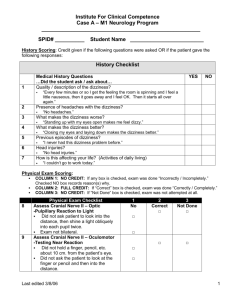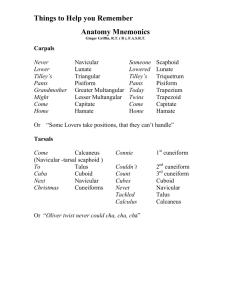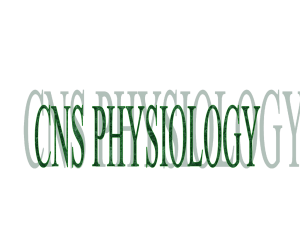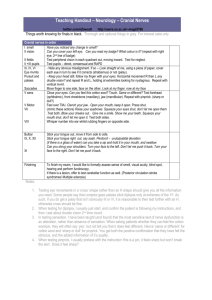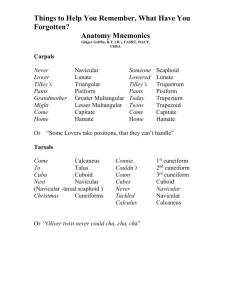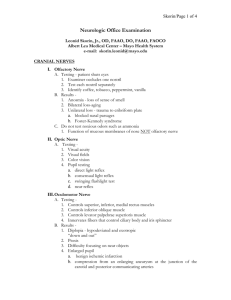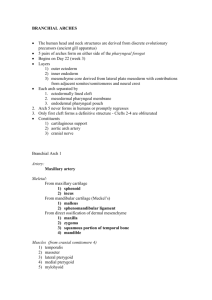Leicester Medical School
advertisement
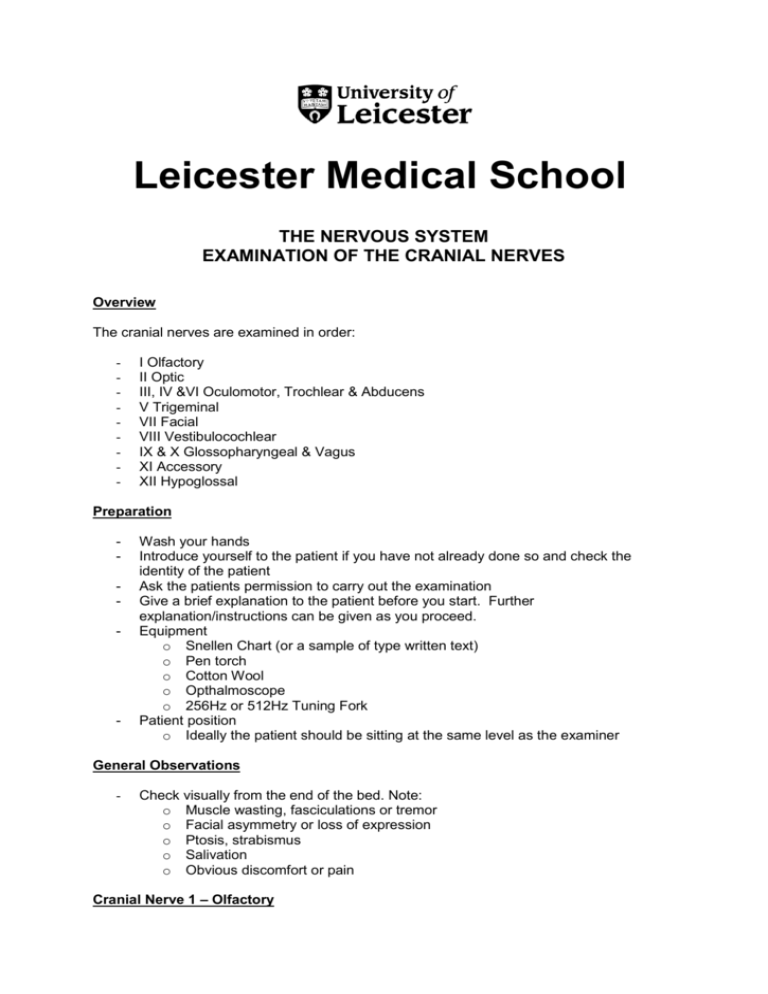
Leicester Medical School THE NERVOUS SYSTEM EXAMINATION OF THE CRANIAL NERVES Overview The cranial nerves are examined in order: - I Olfactory II Optic III, IV &VI Oculomotor, Trochlear & Abducens V Trigeminal VII Facial VIII Vestibulocochlear IX & X Glossopharyngeal & Vagus XI Accessory XII Hypoglossal Preparation - - Wash your hands Introduce yourself to the patient if you have not already done so and check the identity of the patient Ask the patients permission to carry out the examination Give a brief explanation to the patient before you start. Further explanation/instructions can be given as you proceed. Equipment o Snellen Chart (or a sample of type written text) o Pen torch o Cotton Wool o Opthalmoscope o 256Hz or 512Hz Tuning Fork Patient position o Ideally the patient should be sitting at the same level as the examiner General Observations - Check visually from the end of the bed. Note: o Muscle wasting, fasciculations or tremor o Facial asymmetry or loss of expression o Ptosis, strabismus o Salivation o Obvious discomfort or pain Cranial Nerve 1 – Olfactory - Ask the patient if they have noticed any change or loss of their sense of smell Cranial Nerve 2 – Optic Visual Acuity - If patient wears glasses, they should keep them on for testing acuity - Ask the patient to cover one eye and read a sample of text with the other. o Formally tested with a Snellen Chart o Magazines or books can be used at the bedside - Repeat with the other eye. - Note any significant difference between the eyes Visual Fields - Sit directly opposite the patient with your eyes at the same level - Ask the patient to cover their right eye with the right hand - Cover your own left eye with your left hand. - Ask the patient to look directly into your exposed eye as you do the same - Extend your right arm fully and bring in your right hand in slowly from the periphery while moving the index and middle fingers. Keep your hand midway between yourself and patient - Ask the patient to tell you when they first can see your fingers o You should both see them at the same time. o If finger movements are not detected, continue movement toward the centre of vision until the patient sees them - Repeat for all quadrants of the visual field of the patients right eye - Repeat for the other eye Fundoscopy - You should be aware that inspection of the eye optic nerve head (or optic disc) using an ophthalmoscope would normally be expected as part of a cranial nerve examination. - You will learn this skill in Phase II Pupillary Response - Light reflex - Shine light into the right eye - Look for constriction in the pupil of both the illuminated eye (direct reflex) and equal constriction in the contra lateral eye (consensual reflex) - Repeat for the left eye Pupillary Response – The Optic Nerve is purely sensory. The Oculomotor nerve supplies the sphincter muscles of the iris causing constriction of the pupil and the ciliary muscle which focuses the lens for near vision Pupillary Response - Accommodation - Hold your index finger up about a meter from the patient - Ask the patient to focus on your finger while you advance it toward their nose - Watch for constriction of the pupils in response to convergence and accommodation Cranial Nerves 3, 4 & 6 – Oculomotor, Trochlear and Abducens - The patient should sit facing you with their eyes looking straight ahead Inspect the position of the eyelids for ptosis Note the position of the eyes in the resting gaze Ask the patient to follow the movement of your index finger with their head still, moving their eyes only. Move your index finger in an H shape in front of the patient so that the patients eyes are seen to move fully to right, left, superior, inferior and oblique. o look for extra ocular palsy and nystagmus o ask the patient to tell you if they have any double vision o Avoid extremes of gaze as this can cause a physiological nystagmus Cranial Nerve 5 - Trigeminal Sensory - Lightly touch the patients face with cotton wool in the ophthalmic, maxillary and mandibular divisions, comparing each side. - Corneal reflex o This is uncomfortable, so may be omitted if a lesion is not suspected. o Ask the patient to look up to the ceiling and gently pull down the lower eyelid o Very lightly touch the lateral edge of the cornea with a wisp of damp cotton wool o Look for direct and consensual blinking o It is important to touch the sensitive cornea and not the insensitive sclera. Motor - Inspect for any obvious wasting of the muscles of mastication - Ask the patient to clench their teeth - Feel for contractions of temporalis muscles and also the masseter muscles at the angle of the jaw. - Ask the patient to open their jaw and to keep it open. Try and close the patient‟s mouth – the pterygoids are strong; you should not be able to overcome the movement - Ask the patient to move jaw side to side (pterygoid muscles) and look for equal movement Cranial Nerve 7 – Facial Inspect for any asymmetry with the patient Conductive Deafness If the air relaxed passages are blocked or in the - Ask the patient to raise their eyebrows as high presence of middle ear disease then as they can, whilst you gently push down (frontalis muscle). air conduction will be reduced but - Ask the patient to screw up their eyes and perception of sound through bone resist you opening them (Orbicularis conduction will be preserved. Abducens innervates lateral rectus oculi) Rinne’s test will negative muscles - damage willbegive weak(bone - Ask the patient to smile and show their louder than air lateral conduction gaze teeth (Orbicularis Oris) Trochlear nerve innervates right and conduction). - Ask the patient to blow out their cheeks left superior oblique muscles - itsis louder Weber’s test will find sound (Buccinators) action in is the demonstrated affected ear.by asking o weakness can be exaggerated by the patient to look downwards and tapping the cheek and checking inwards for continence of air Oculomotor nerve innervates all remaining ocular muscle and the Cranial Nerve 8 – Vestibulocochlear levator palpebrae superioris, weakness in which results in ptosis. Simple Test of Hearing - - - Whisper in each of the patients ears in turn (whilst covering the other), and ask them to repeat what is said. Alternatively, make a noise in each ear in turn (e.g. rub fingers against thumb) and ask the patient so say when you stop. Rinne’s test - Tap a 256 or 512Hz tuning fork - Hold adjacent to the right ear, say “This is sound 1” - Apply base of tuning fork to mastoid process, say “This is sound 2” - Ask the patient which sound is the loudest - Repeat for the left ear Sensorineural Deafness If the auditory nerve or cochlear is affected then the perception of sound through both air and bone conduction will be reduced. Rinne’s test will be positive (air conduction louder than bone conduction). Weber’s test will find sound is louder in the unaffected ear. Weber’s Test - Tap a 256 or 512Hz tuning fork - Hold the base centrally against the forehead - Ask, “Does it sound louder on one side, or is it the same on both sides?” In a normal individual Rinne‟s Test will be positive, i.e. air conduction (sound 1) will be louder than bone conduction (sound 2). Weber‟s test will find the sound to be perceived equally by both ears. Cranial Nerves 9 & 10 are tested together as they work together to control the larynx, pharynx and swallow. Cranial Nerves 9 & 10 Glossopharyngeal and Vagus - Ask the patient to cough (damage gives a „bovine‟ cough) Ask the patient to open the mouth. Inspect the soft palate and uvula. The uvula should be central Ask the patient to say „Aaah.‟ The uvula and soft palate should move upwards and not deviate to one side Gag reflex o This is not usually tested in the conscious patient o Touch the posterior pharyngeal wall on one side with a sterile stick o The uvula and soft palate should rise with the gag reflex N.B. You may not be able to visualise the uvula in the case of a strong gag reflex o Repeat on the other side of the posterior pharyngeal wall o Ask if the patient felt the touch equally on both sides Cranial Nerve 11 Accessory Cranial Nerve 11 innervates the upper fibres of trapezius and the sternomastoid muscles. - Ask the patient to shrug their shoulders using your hands on their shoulders to resist the movement. - Ask the patient to turn their head to each side using your hand on their cheek to resist the movement - Note any asymmetry Cranial Nerve 12 Hypoglossal - Ask the patient to open the mouth Inspect the tongue for wasting and fasciculation Ask the patient to protrude the tongue and look for deviation Ask them to move the tongue from side to side Place your finger on the patient‟s cheek and ask them to push against it using their tongue. Repeat for the other side. Completing the Examination - Thank the patient For completion you should also consider: o Neurological examination of the limbs o Mental state examination


